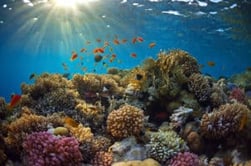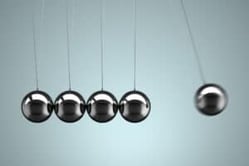Solids, Liquids, and Gases Lesson Plan - A Complete Science Lesson Using the 5E Method of Instruction
At the end of this solids, liquids, and gases lesson plan, students will be able to predict what changes will occur in particle motion, temperature, and state of a pure substance when thermal energy is added or removed. Each lesson is designed using the 5E method of instruction to ensure maximum comprehension by the students.
The following post will walk you through each of the steps and activities from the solids, liquids, and gases lesson plan.
ENGAGEMENT
Objective Introduction
At the beginning of the lesson, the class will do a Think-Pair-Share to discuss the objective.
Class Activity
- Fill an empty soda or water bottle with hot water. Swirl the water around to make the bottle hot, and pour it out.
- Refill the bottle 1/4 full with hot water and place a balloon over the top.
- Now, fill a bowl with ice water, and place the bottle in the bowl.
- Watch as all of the air is taken from the balloon. It might even get pulled into the bottle!
Student Activity
Questions to ask the students as they watch the demonstration:
- What happens to the balloon when you place it into cold water?
- What would happen to the balloon when you place the bottle into the hot water?
- What happens to the air (gas) in the bottle when you place the bottle into cold ice water/hot water?
- What causes this change in the gas in the bottle/balloon?
- What would happen to the water in the bottle if more heat was removed?
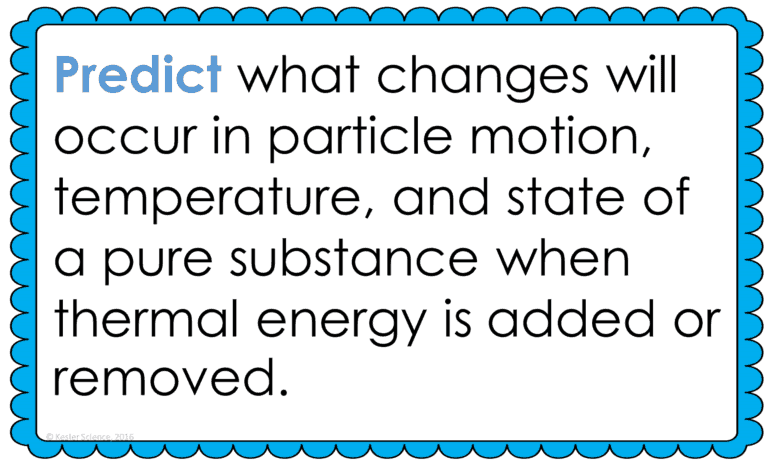
The teacher will help to clear any misconceptions about solids, liquids, and gases. Some major misconceptions students have are when water boils and bubbles, the bubbles are air (oxygen or hydrogen), steam is hot air, when steam is no longer visible it becomes air.
Estimated Class Time for the Engagement: 20-30 minutes
EXPLORATION
This student-centered station lab is set up so students can begin to explore solids, liquids, and gases. Four of the stations are considered input stations where students are learning new information about solids, liquids, and gases and four of the stations are output stations where students will be demonstrating their mastery of the input stations. Each of the stations is differentiated to challenge students using a different learning style. You can read more about how I set up the station labs here.
EXPLORE IT!
Students will be working in pairs to better understand the state of matter. Students will need to wear goggles for this station as they will be conducting a lab to explore solids, liquids, and gases and even vaporization and sublimation. Students will relate the movement of atoms within the molecules of water to each state of matter.
WATCH IT!
At this station, students will be watching a short video explaining the states of matter and how they transform from one state to another. Students will then answer questions related to the video and record their answers on their lab station sheet. For example: How are molecules related to the states of matter? Compare and contrast evaporation and condensation. Make a T-chart with the 3 states of matter and list how the molecules move in each state.
RESEARCH IT!
The research station will allow students to conduct research about the phases of matter. Before this station, students have only been taught about the main three. Once students complete this station, they will understand that there are 2 more and how they compare to the others. Students will then be directed to answer a few questions based on the research they conducted.
READ IT!
This station will provide students with a one page reading about dry ice. In the reading, students will discover the process that dry ice undergoes, sublimation. Students will learn that certain solids can skip the liquid phase and go straight to the gas phase. There are 4 follow-up questions that the students will answer to show reading comprehension of the subject.
ASSESS IT!
The assess it station is where students will go to prove mastery over the concepts they learned in the lab. The questions are set up in a standardized format with multiple choice answers. Some questions include: How does the addition of thermal energy relate to the molecules in a substance? Fog appearing on glasses is know as what process? Steam coming off a pond after a cold front moves through is know as what process? The type of energy which has the greatest impact on the state of matter is known as what energy?

WRITE IT!
Students who can answer open-ended questions about the lab truly understand the concepts that are being taught. At this station the students will be answering three task cards: Describe how thermal energy affects atoms within the 3 state of matter. Describe the process of sublimation. List 3 different phase changes you might see on a bus ride to school on a very cold morning.
ILLUSTRATE IT!
Your visual students will love this station. Students will draw an image that represents what atoms look like in a solid, liquid and a gas.
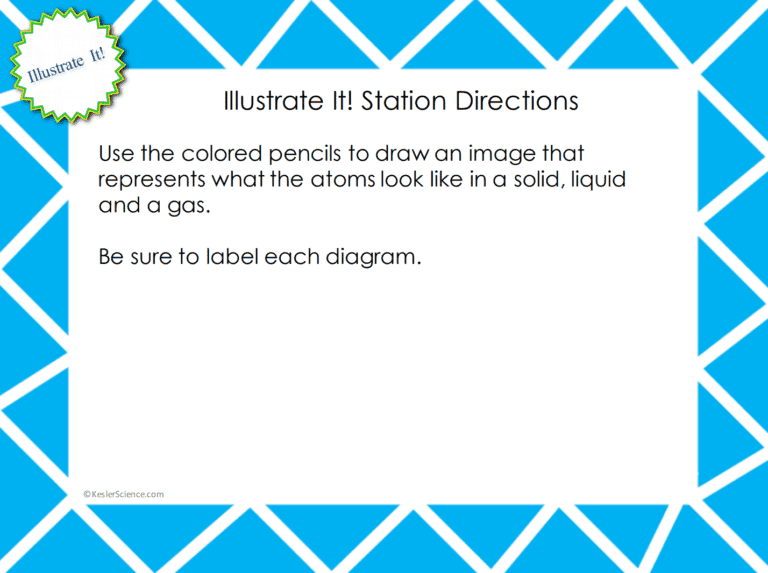
ORGANIZE IT!
The organize it station allows your students to place vocabulary terms to the correct definition.
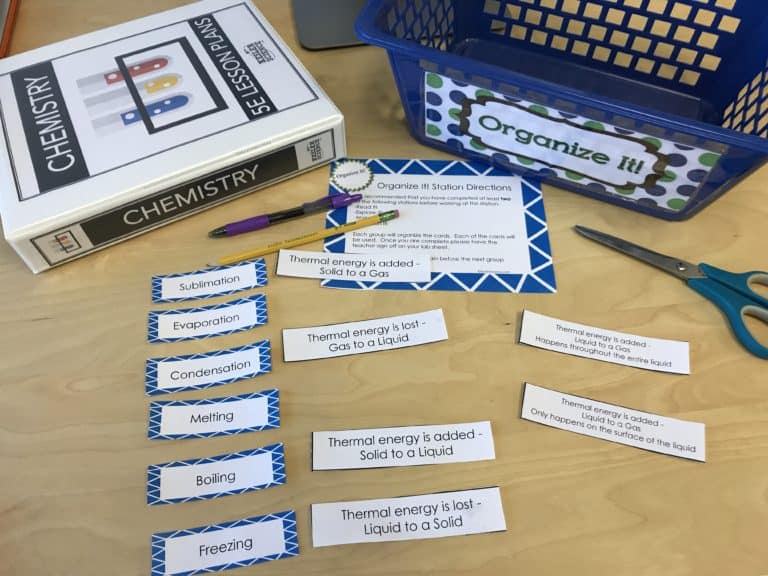
Estimated Class Time for the Exploration: 1-2, 45 minute class periods
EXPLANATION
The explanation activities will become much more engaging for the class once they have completed the exploration station lab. During the explanation piece, the teacher will be clearing up any misconceptions about solids, liquids, and gases with an interactive PowerPoint, anchor charts, and interactive notebook activities. The solids, liquids, and gases lesson includes a PowerPoint with activities scattered throughout to keep the students engaged.

The students will also be interacting with their journals using INB templates for solids, liquids, and gases. Each INB activity is designed to help students compartmentalize information for a greater understanding of the concept. The solids, liquids, and gases INB templates allow students to focus their notes on learning to the difference between each phase of matter, and notes on solids, liquids, and gases.
Estimated Class Time for the Exploration: 2-3, 45 minute class periods
ELABORATION
The elaboration section of the 5E method of instruction is intended to give students choice on how they can prove mastery of the concept. When students are given choice the ‘buy-in’ is much greater than when the teacher tells them the project they will have to create. The elaboration project will allow students to create a presentation to teach about solids, liquids, and gases.
Estimated Class Time for the Elaboration: 2-3, 45 minute class periods (can also be used as an at-home project)
EVALUATION
The final piece of the 5E model is to evaluate student comprehension. Included in every 5E lesson is a homework assignment, assessment, and modified assessment. Research has shown that homework needs to be meaningful and applicable to real-world activities in order to be effective. When possible, I like to give open-ended assessments to truly gauge the student’s comprehension.
Estimated Class Time for the Elaboration: 1, 45 minute class period
DOWNLOAD THE FULL LESSON NOW
The full lesson is available for download from the Kesler Science Store. Save yourself a ton of time and grab it now.
Download Over $100 in FREE Resources
For Middle School Science
Simply create a login below and gain immediate access to a selection of our Kesler Science product line worth $100 - for FREE. There's a full version of every product type! You'll also join tens of thousands of middle school science teachers who receive timely tips and strategies straight to their inbox.


.png)
